That Moment In ‘Behind Enemy Lines’: Tripwire Tango
Behind Enemy Lines is a 2001 action-thriller about a Navy navigator shot down over enemy territory who must fight to stay alive while awaiting a rescue that might not come.
While flying a reconnaissance mission in a F/A-18 Hornet fighter jet near the demilitarized zone along the Bosnian border near the end of that war, pilot Lieutenant Jeremy Stackhouse (Gabriel Macht) and flight officer Lieutenant Chris Burnett (Owen Wilson), take pictures of some suspicious activity, which turns out to be a mass grave. It seems proof of an attempted cover-up of the genocide by Bosnia Serb General Miroslav Lokar (Olek Krupa), though the servicemen don’t know that yet, and honestly don’t have time to think about it as a ground to air missile strike takes out their plane. It forces them to eject, and the two become separated as they drift to land. Unfortunately, Stackhouse is captured and executed, but Burnett escapes into the woods hoping to keep one step ahead of the paramilitary types ruthlessly tracking before he can reach the extraction site and tell the world of what he’s learned.

Directed by John Moore, Behind Enemy Lines is loosely-inspired on the real experiences of former U.S. Air Force Captain Scott O’Grady, though made without his consent, leading to some legal actions, but nonetheless, the movie itself is hardly representative of the truth and falls in line with a number of obvious hero-type movies with over-the-top action and explosive stunts that have come to define the genre.
That said, when you think of a military action/drama movie star during the early 2000s, right away, only a few names pop to mind. Probably Bruce Willis, Keanu Reeves, or Sylvester Stallone. Owen Wilson surely isn’t on that list. He’s the guy who played a ditzy male model in a screwball comedy opposite Ben Stiller. How could he be an action star? To this point, he had hardly padded his resume with action flicks, aside from his brief role in Armageddon and some bits with Jackie Chan in Shanghai Noon, and seemed like a strange pick for the lead, though that was the idea in casting an everyman style of character to bring some credibility to it all, à la Willis in Die Hard before that turned him into, well, the first name on the above list.
Wilson buzz-cuts his hair and spend the majority of the movie running around a worn torn Eastern European city in a green, jet fighter jumpsuit avoiding gunfire and despite the film’s overall delivery, does a good job with the part, once we get over the bridge where we realize we are supposed to take him seriously. Then there’s gruff Rear Admiral Leslie McMahon Reigart, played with voracity by Gene Hackman, defying orders to bring his man home in a part that has him chewing scenery and living up to the film’s tropes. The movie itself is generic and obvious and should have been better, but like every movie, it has one great moment. Let’s talk about it.
Tripwire Tango
After their plane is shot down, from a distance, Burnett witnesses Stackhouse’s execution, but also gives away his location in doing so, which prompts Lokar to send his best men, Colonel Bazda (Marko Igonda) and a ruthless assassin named Sasha (Vladimir Mashkov) to mercilessly hunt him down. This sets up the film’s narrative as Burnett is forced to keep moving while he steadily faces impending death by mindless killers.
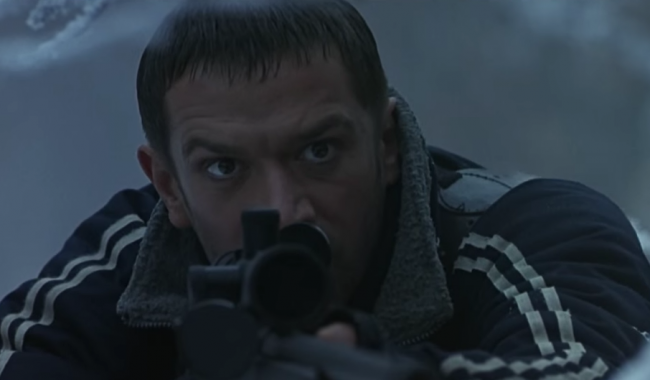
At one point, Burnett enters a gutted industrial complex and train yard, ravaged by war. It is also littered with trip mines and trip wires, the triggers zig-zaging their way along a short stretch of road in such a labyrinthine cluster it looks like the web of a paranoid militant spider with severe proximity issues.

Standing with his toes on the edge of the trap, Burnett looks ahead to see a boy and his younger sister hoping over them, which makes him realize there’s a lot more than he thought, and also that these people live with this every day. And also, if they can do it …

As much as the explosives are a hurdle in front of him, the real problem is what’s behind him. Three soldiers in a truck spot him and close in, automatic weapons drawn. With his toes edging up onto the first wire, Burnett has no choice but to risk a run. Taking a breath, he hurls himself forward, skipping and hopping through the narrow path while his enemy pursuers …
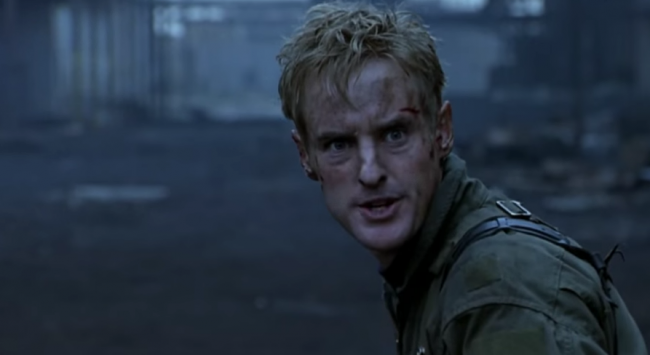
Well. Okay, so in the heat of the moment, perhaps swept up in the possible glory they believe will befall them in capturing and mowing down the vile American, one of them gets a little too eager. Aiming his AK-47 at the fleeing target, he puts his foot down right on the wire. This proves to be a bad idea.
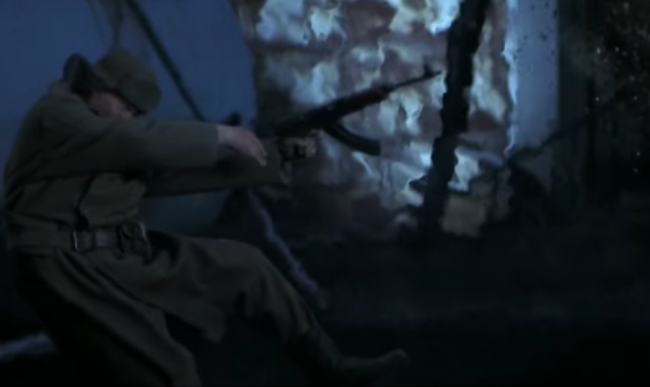
A cacophony of smoke, fire, shrapnel and Hollywood-esque everything-goes-boom awesomeness, the train yard lights up and the camera slows down as the nameless soldiers billow back like sacks of man-shaped meat in the ensuing chaos. Meanwhile, Burnett, blown down by the bast, misses the triggers at his feet, but quickly jumps back to the task as a ripple effect of explosions cascade their way toward him as each concussive eruption sets off the next. Time to bolt.
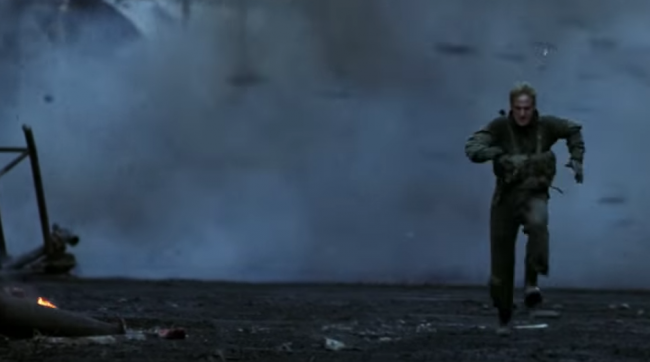
It will come as no surprise that Burnett survives, but what is surprising is how well the sequence works. Sure it’s pandering to action, and the logic behind both the footfall of the soldier and the minefield itself stretch believability to its limits (if the first blast knocks Burnett down, why don’t the myriad others that follow do the same?), but as an action moment, it’s done with great effectiveness. The extreme slo-motion imagery of the soldier getting tossed back by the first explosion is truly mesmerizing as we watch in extreme slow speed his body fold and hurl off camera, clearly a practical effect where a stuntman was yanked with some pretty sizable force.
Moore keeps the sequence dialogue-free, providing great visual cues as to what the scene will be about, giving us wide and close-up shots of the terrain and Burnett’s expressions as it unravels. This is key to creating the tension and delivering the necessary information in following the action through to the end. It’s really well set up and executed.
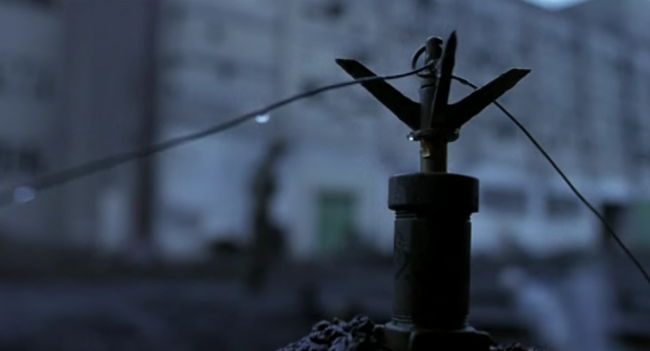
Behind Enemy Lines is a throw-away thriller, formulaic and by-the-numbers, and taps into our baser expectations of heroes and saviors, yet despite its themes and overall effect, there are some positives, including Owen’s gritty performance and some well-directed action set pieces. Worth a look for enthusiasts of the genre, keep an eye on the Tripwire Tango scene and soak in a great movie moment.
